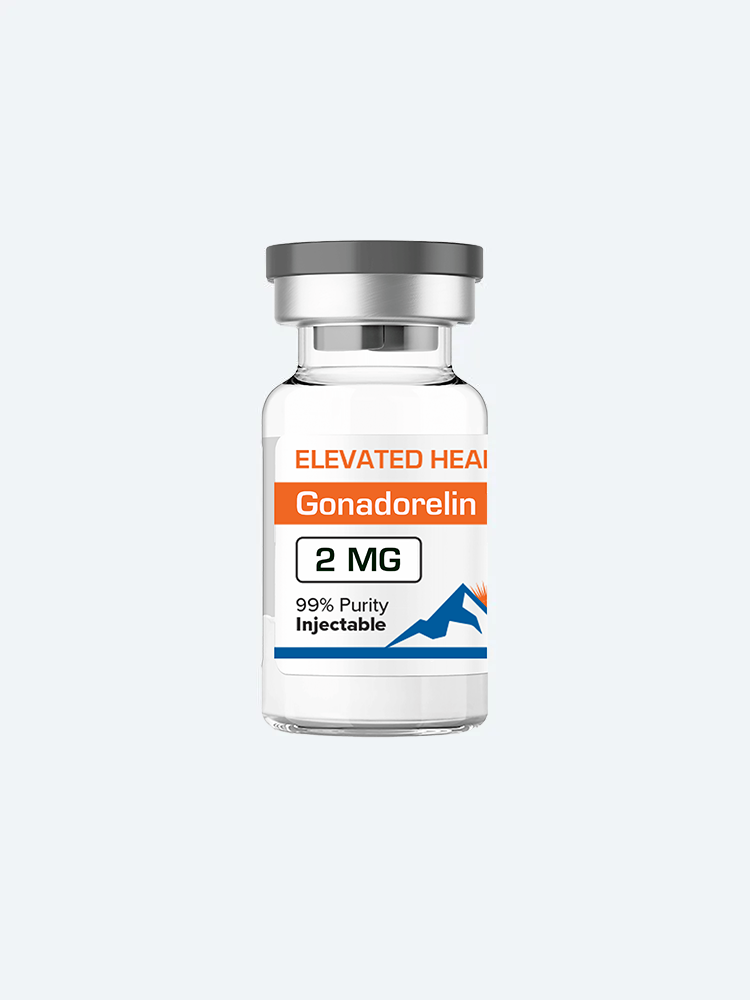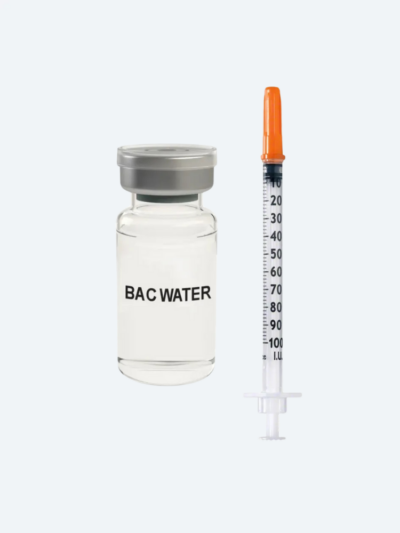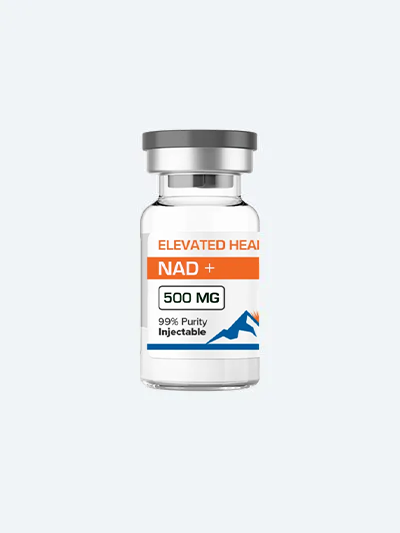No products in the cart.
Back


In stock
Gonadorelin
Fertility, Men's Health, Peptides$40.00
SKU: 29045-SB-9-54
2 mg
Injectable
Ingredients – 2 mg Gonadorelin Peptide
Indications – Stimulates luteinizing & follicle-stimulating hormone release, treats infertility & hypogonadism, potential Alzheimer’s benefit
Dosage – 100-200mcgs, 2-3 times per week
Gonadorelin is the synthetic version of the naturally occurring gonadotropin hormone-releasing hormone (GnRH) composed of ten amino acids. GnRH is considered to be a major regulator in the secretion of gonadotropins, i.e. follicle-stimulating hormone (FSH) and luteinizing hormone (LH), both of which are considered to manage and regulate the endocrine functioning and maturation of the gonads. Gonadorelin has shown benefit in the treatment of infertility and hypogonadism. Recent research suggests that gonadorelin may be useful in slowing the growth of breast and prostate cancer. Studies also show promise in the treatment of Alzheimer’s disease.
- Description
Overview
The peptide has been suggested to stimulate the synthesis and release of gonadotropins, the luteinizing hormone, and the follicle-stimulating hormone by possibly stimulating the GnRH receptors in the anterior pituitary gland cells. This is mainly the reason why Gonadorelin is referred to by researchers as a “GnRH agonist,” as it may possibly induce the same action as GnRH.
Gonadorelin Peptide and Testicular Function
Studies have investigated the potential of intermittent Gonadorlein exposure on the HPG axis, which may mimic the natural synthesis of GnRH and its action on the pituitary cells. In particular, this scenario was studied in models of hypothalamic dysfunction, where the production of native GnRH appeared to have been disturbed. Researchers have shared that Gonadorelin may effectively ” kick-start” the HPG axis in such scenarios, which involves sequential stimulation of the pituitary gland cells to synthesize LH and FSH, and then the testicular cells to produce androgens. They comment that intermittent exposure to the peptide for 5 to 6 months may ultimately result in successful spermatogenesis. This process appears to be highly dependent on the endogenous production of testosterone by testicular cells.
Gonadorelin Peptide and Post-Cycle Steroid Recovery
Exogenous androgens may potentially suppress the function of the hypothalamic-pituitary-gonadal (HPG) axis, which is considered to form between the structures of the hypothalamus, the pituitary gland, and the gonads. For example, exogenous androgens are suggested to mediate negative feedback to the pituitary gland, thereby suppressing the release of LH and FSH. Once the exposure to exogenous androgens has ceased, HPG may slowly recover, but Gonadorelin may offer a potential mechanism to speed up the process.
Gonadorelin Research and Breast Cancer Prevention
Research suggests that having a higher life-time exposure to estrogen may increase a woman’s chance of developing breast cancer. Women who start their period at a younger age, go through menopause at a later age, take estrogen-containing birth control, or have menopausal hormone replacement therapy all have a higher risk of developing breast cancer. Thankfully, in the case of birth control, the risk diminishes when the pills are no longer taken and eventually the increased risk returns to baseline. Of course, birth control is a double-edged sword because even though its use increases risk of breast cancer, it decreases risk of ovarian cancer.
Some breast cancer cells require estrogen to grow and minimizing estrogen production or blocking estrogen receptors has long been an established method for treating certain forms of breast cancer. Research into gonadorelin shows that it can be used to suppress ovarian production of estrogen and that this may be a means of preventing breast cancer in the first place. This concept is based on the idea that some women, due to genetic and environmental factors, are at higher risk of developing breast cancer in their postmenopausal years. The use of gonadorelin in this setting is safe and cost-effective, making it an attractive means of reducing cancer burden. Research suggests that using gonadorelin for 10 years could reduce the risk of breast cancer by as much as 50% and that using it for 15 years could reduce risk by 70%.
The benefits of gonadorelin do not stop at breast cancer prevention, however, Research indicates that adjuvant therapy with anti-estrogens reduces disease progression by as much as 50% in cases where cancer is sensitive to estrogen. Unfortunately, currently available treatments are limited in their efficacy because cancer cells tend to develop resistance to them over time. This resistance usually arises as a result of increased estrogen receptor expression, making it impossible to block every estrogen receptor without severe side effects. Gonadorelin could circumvent this problem by reducing estrogen expression in the first place. This would not only directly reduce growth of estrogen-sensitive cancer, it would boost the efficacy of receptor blocking medications and extend their useful lifespan.
Research in postmenopausal women with hyperandrogenism (too much estrogen) has revealed that long-term GnRH treatment reduces overall levels of estrogen and thus the risk of developing breast cancer. It does so without serious side effects and thus offers an alternative to the current therapy, which is surgical removal of the ovaries.
Gonadorelin May Reduce Dementia Risk
Research indicates that sex hormones, particularly leuteinizing hormone (LH), act on the brain in ways that are well outside the scope of sexual dimorphism or reproductive capacity. In fact, the associated rise in LH that occurs with menopause has been correlated with an increased incidence of Alzheimer’s disease and decreased memory performance in both humans and animals. Careful research in rats further reveals that LH acts directly on the hippocampus, the primary memory center in the brain. Rats given LH exhibit decreased memory performance and hippocampus dysfunction, a deficit that is reverse by administration of an LH blocking drug.
Further research on LH has revealed that higher levels of the hormone are associated with increased neuropathology. In particular, it has been revealed that LH promotes the development of plaques associated with Alzheimer’s. It stands to reason then that reducing LH levels may help to reduce the progression of Alzheimer’s disease. This has been born out, at least partially, in mouse models showing that getting rid of the LH receptor in the brain improves amyloid pathology and helps to preserve the health of cells like astrocytes, which support and protect neurons.
As it turns out, testosterone is beneficial to brain health and actually helps to preserve cognitive function. Thus, simply blocking the entire hypothalamic-pituitary-gondal axis is not necessarily an effective means of treating Alzheimer’s disease. That is why scientists have set out to test gonadorelin derivatives to discern if selective interference in LH production is possible and can have potential benefits. This research, while ongoing, has led to the understanding that leuprolide (a common medication used to treat uterine fibroids and a GnRH receptor agonist) is effective in decreasing the risk of Alzhimer’s compared to other gonadorelin analogues.
New research is seeking to understand how gonadorelin and its analogues affect APOE and MS4A6A expression in Alzheimer’s disease. Both genetic loci are associated with late-onset Alzheimer’s disease, but research suggests that they need to operate in tandem to produce serious problems and that interfering with one gene loci or the other is enough to short-circuit the pathway to pathology. Gonadorelin affects this process of tandem interaction, but it isn’t clear how or why. Right now, researchers are working to understand how the interaction of genes in Alzheimer’s disease can be interrupted to both treat and prevent the condition. Gonadorelin is am important peptide in that research.
References:
Marques P, Skorupskaite K, George JT, et al. Physiology of GNRH and Gonadotropin Secretion. [Updated 2018 Jun 19]. In: Feingold KR, Anawalt B, Boyce A, et al., editors. Endotext. South Dartmouth (MA): MDText.com, Inc. https://www.ncbi.nlm.nih.gov/books/NBK279070/
National Center for Biotechnology Information. PubChem Compound Summary for CID 638793, Gonadorelin.
Philip GA Thomas, Alain Fontbonne, Drugs and reproduction. https://www.sciencedirect.com/topics/pharmacology-toxicology-and-pharmaceutical-science/gonadorelin-acetate
van Breda, E., Keizer, H. A., Kuipers, H., & Wolffenbuttel, B. H. (2003). Androgenic anabolic steroid use and severe hypothalamic-pituitary dysfunction: a case study. International journal of sports medicine, 24(3), 195–196. https://doi.org/10.1055/s-2003-39089
Blumenfeld, Z., Makler, A., Frisch, L., & Brandes, J. M. (1988). Induction of spermatogenesis and fertility in hypogonadotropic azoospermic men by intravenous pulsatile gonadotropin-releasing hormone (GnRH). Gynecological endocrinology : the official journal of the International Society of Gynecological Endocrinology, 2(2), 151–164. https://doi.org/10.3109/09513598809023623
Zhang, L., Cai, K., Wang, Y., Ji, W., Cheng, Z., Chen, G., & Liao, Z. (2019). The Pulsatile Gonadorelin Pump Induces Earlier Spermatogenesis Than Cyclical Gonadotropin Therapy in Congenital Hypogonadotropic Hypogonadism Men. American journal of men’s health, 13(1), 1557988318818280. https://doi.org/10.1177/1557988318818280
Muzzi, G., Bartolotta, E., Cherubini, V., & Lomiento, D. (1990). Effetti del trattamento con LH-RH sintetico spray nasale nel criptorchidismo [Effects of the treatment using synthetic LH-RH nasal spray in cryptorchism]. La Pediatria medica e chirurgica : Medical and surgical pediatrics, 12(1), 53–55.
Lepor, Herbert. “Comparison of single-agent androgen suppression for advanced prostate cancer.” Reviews in urology vol. 7 Suppl 5,Suppl 5 (2005): S3-S12. https://www.ncbi.nlm.nih.gov/pmc/articles/PMC1477619/
Spicer DV, Pike MC. Sex steroids and breast cancer prevention. J Natl Cancer Inst Monogr. 1994;(16):139-47. https://pubmed.ncbi.nlm.nih.gov/7999456/
Secreto G, Sieri S, Agnoli C, Grioni S, Muti P, Zumoff B, Sant M, Meneghini E, Krogh V. A novel approach to breast cancer prevention: reducing excessive ovarian androgen production in elderly women. Breast Cancer Res Treat. 2016 Aug;158(3):553-61. https://pubmed.ncbi.nlm.nih.gov/27393623/
Zerbib M. Analogues de la GnRH dans le traitement du cancer de la prostate [GnRH analogs and prostate cancer treatment]. Ann Urol (Paris). 2005 Oct;39 Suppl 3:S66-72. French. doi: 10.1016/s0003-4401(05)80011-7. https://pubmed.ncbi.nlm.nih.gov/16302714/
Bhasin S, Yuan QX, Steiner BS, Swerdloff RS. Hormonal effects of gonadotropin-releasing hormone (GnRH) agonist in men: effects of long term treatment with GnRH agonist infusion and androgen. J Clin Endocrinol Metab. 1987 Sep;65(3):568-74. https://pubmed.ncbi.nlm.nih.gov/3114307/
R.L Bowen, et al, Not All Androgen Deprivation Therapies Are Created Equal: Leuprolide and the Decreased Risk of Developing Alzheimer’s Disease, J. Clin. Oncol., vol 34, no. 23, p.2800, Aug 2016. https://ascopubs.org/doi/full/10.1200/JCO.2015.66.3997
Vesper B, Rohde W, Groot-Wassink T. Ein Beitrag zur klinischen Anwendung von Gonadorelin als Diagnostikum im Einfach- und Doppelbelastungstest [Clinical use of Gonadorelin as a diagnostic agent in one- and two-step tests]. Zentralbl Gynakol. 1986;108(23):1442-52. https://pubmed.ncbi.nlm.nih.gov/3103350/
G. Secreto et al., “A novel approach to breast cancer prevention: reducing excessive ovarian androgen production in elderly women,” Breast Cancer Res. Treat., vol. 158, no. 3, pp. 553–561, 2016.
D. V. Spicer and M. C. Pike, “Sex steroids and breast cancer prevention,” J. Natl. Cancer Inst. Monogr., no. 16, pp. 139–147, 1994.
G. Secreto, P. Muti, M. Sant, E. Meneghini, and V. Krogh, “Medical ovariectomy in menopausal breast cancer patients with high testosterone levels: a further step toward tailored therapy,” Endocr. Relat. Cancer, vol. 24, no. 11, pp. C21–C29, 2017.
E. S. Vollaard, A. P. van Beek, F. A. J. Verburg, A. Roos, and J. A. Land, “Gonadotropin-releasing hormone agonist treatment in postmenopausal women with hyperandrogenism of ovarian origin,” J. Clin. Endocrinol. Metab., vol. 96, no. 5, pp. 1197–1201, May 2011.
F. Labrie, “Hormonal therapy of prostate cancer,” Prog. Brain Res., vol. 182, pp. 321–341, 2010.
F. Labrie, “GnRH agonists and the rapidly increasing use of combined androgen blockade in prostate cancer,” Endocr. Relat. Cancer, vol. 21, no. 4, pp. R301-317, Aug. 2014.
F. Labrie, “Combined blockade of testicular and locally made androgens in prostate cancer: a highly significant medical progress based upon intracrinology,” J. Steroid Biochem. Mol. Biol., vol. 145, pp. 144–156, Jan. 2015.
F. Labrie, “[Key role of endocrinology in the victory against prostate cancer],” Bull. Cancer (Paris), vol. 93, no. 9, pp. 949–958, Sep. 2006.
V. Burnham, C. Sundby, A. Laman-Maharg, and J. Thornton, “Luteinizing hormone acts at the hippocampus to dampen spatial memory,” Horm. Behav., vol. 89, pp. 55–63, 2017.
C. V. Rao, “Involvement of Luteinizing Hormone in Alzheimer Disease Development in Elderly Women,” Reprod. Sci. Thousand Oaks Calif, vol. 24, no. 3, pp. 355–368, 2017.
J. Lin et al., “Genetic ablation of luteinizing hormone receptor improves the amyloid pathology in a mouse model of Alzheimer disease,” J. Neuropathol. Exp. Neurol., vol. 69, no. 3, pp. 253–261, Mar. 2010.
R. L. Bowen, T. Butler, and C. S. Atwood, “Not All Androgen Deprivation Therapies Are Created Equal: Leuprolide and the Decreased Risk of Developing Alzheimer’s Disease,” J. Clin. Oncol., vol. 34, no. 23, p. 2800, Aug. 2016.
M. A. Smith, R. L. Bowen, R. Q. Nguyen, G. Perry, C. S. Atwood, and A. A. Rimm, “Putative Gonadotropin-Releasing Hormone Agonist Therapy and Dementia: An Application of Medicare Hospitalization Claims Data,” J. Alzheimers Dis. JAD, vol. 63, no. 4, pp. 1269–1277, 2018.
A. Cáceres, J. E. Vargas, and J. R. González, “APOE and MS4A6A interact with GnRH signaling in Alzheimer’s disease: Enrichment of epistatic effects,” Alzheimers Dement. J. Alzheimers Assoc., vol. 13, no. 4, pp. 493–497, Apr. 2017.
REMINDER TO ALL CUSTOMERS:
Due to their sensitive nature and strict storage requirements: all sales are final on peptides & GH products. We cannot accept returns strictly because of product integrity and safety for all clients. Thank you for your understanding
Related products
- AOD-9604, 5mg, 3 Pack
$240.00Original price was: $240.00.$216.00Current price is: $216.00. - NAD+ 500mg 3 pack
$327.00Original price was: $327.00.$288.00Current price is: $288.00.






